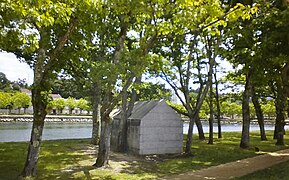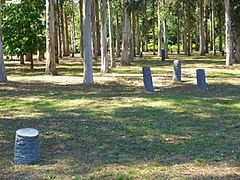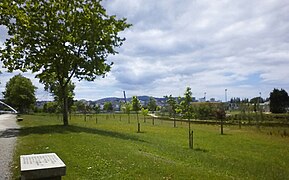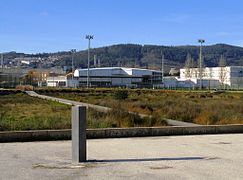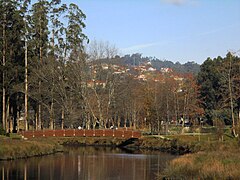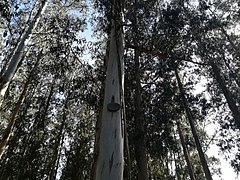Island of Sculptures
| Island of Sculptures | |
|---|---|
 | |
 | |
| Location | Pontevedra, Spain |
| Coordinates | 42°26′22″N 8°38′03″W / 42.439375°N 8.634032°W |
| Area | 0.07 km2 (17.29 acres) |
| Created | 1997 (Park); 1999 (Sculptures) |
| Operated by | Municipality of Pontevedra |
| Status | Public park |
The Covo Island, better known as the Island of Sculptures or Illa das Esculturas in Galician, is a park and island located near the mouth of the Lérez River, in Pontevedra, Spain. It has an area of 70,000 m²[1] and is connected to both banks of the river by footbridges and pedestrian bridges. It is the largest and most important open-air museum in Galicia[2] and one of the most important in Spain.[3]
There is among other a 2 m high labyrinth,[4] a 5 m high pink granite menhir at the crossroads or a floating house on the Lérez river at the bottom of the island.[5] The aquatic fauna includes ducks and carps.
History[edit]
The island was formed in the river from the sediments transported by the Lérez River deposited there because the river is already very close to sea level and loses its strength to carry these sediments away. At first, an intertidal plain was formed, but the Lérez found this obstacle on its way to the ria and sought another alternative route, thus opening a channel on the right side.[6]
The island remained in the wilderness until 1997, when it was transformed into a park.[7] Later, a project for the development of this space was carried out, with the creation of contemporary artworks by 12 internationally renowned artists,[8] · [9] which took as their central theme the granite of Galicia and the relationship of man with his environment. This is the most important example of land art, a trend in contemporary art, in Galicia. The project was officially inaugurated on 29 July 1999.[10]

Description[edit]
The island, which has been declared a protected natural area,[11] is almost a kilometre long[12] and has an elongated shape. It has an area of rushes, meadows, a main path and secondary paths. Three wooden bridges cross the inner canal[13] and a cable-stayed footbridge over the Lérez River connects it to the Paseo del Lérez. On the island there are 12 granite sculptures by international artists.
On the island come the tides and it is used by many birds as a breeding ground. It is a protected area declared LIC (place of community interest).[14] Located near the Pontevedra Campus, the island is also used by many people as a place for walking or sports training.
Sculptures[edit]
The international authors and their sculptural works present on the island are:[15] · [16] · [17]
- The Italian Giovanni Anselmo with Cielo acortado. It is a black granite column from Campo Lameiro of one metre and 20 centimetres that represents the space between heaven and earth.
- The German Ulrich Rückriem with a pink granite Column recalling Galician traditions. It's a 5-metre high stele at a crossroads.
- The American Robert Morris created the Labyrinth of Pontevedra. He recreates with it the oldest petroglyph in Europe: the labyrinth of Mogor located in Marín (Pontevedra) It is circular, two metres high and topped by a black slate roof.
- The Portuguese José Pedro Croft with a House built in grey granite from Mondariz. It is a 3.20 metre construction without doors or windows, which blends in with the surrounding nature. A tree is embedded in its walls as a symbol of nature in motion. The house reflects the small world that man builds for himself within the house that is nature[18] and evokes rural houses absorbed by nature.
- The American Jenny Holzer, who installed Eight grey stone benches on the island's central promenade, with twelve phrases or aphorisms of reflective intent inscribed on each one. The eight benches give art an everyday utility.[19]
- The English Richard Long with Pontevedra Line, a small wall 37 metres long, made of pieces of white granite, which evokes the idea of the walk as action and thought.
- The Scottish Ian Hamilton Finlay with Three green slate medallions hanging from eucalyptus trees, made of green granite, with the inscription Petrarch and Roman numerals corresponding to sonnets. It is a set of three green slate medallions engraved with the name of the Italian poet and the Roman number of a sonnet on each piece: Petrarch XXXV, Petrarch CXXXII and Petrarch CCCX. Finlay invites the spectator to search and discover what is hidden in this numerical key. These are verses of love and solitude with which the viewer enters into communication. The medallions are located on three eucalyptus trees five metres high, each facing a different cardinal point to play with the sun at different times of the day.[20]
- The French Anne and Patrick Poirier with Folie, a 3,000 square metre garden, outside the island to be viewed from it. The work is made of stainless steel, grey granite, plants and trees.[21]
- The American Dan Graham with Pyramid. The pink granite pyramid is 1.9 metres high, doubles in the waters of the river and contains three carved inverted pyramids. The work seeks the effect of light refraction and the granite is polished to achieve this effect. The pyramid is placed near the water of the river to obtain the reflection of the water as if it were a double pyramid.[22]
The Spanish artists and their works are:[23]
- Fernando Casás represents The 36 righteous who sustain the world of the Hebrew tradition by means of 36 blocks of black granite, like trunks of a felled and devastated forest, distributed throughout the island's own forest.
- Francisco Leiro with Saavedra installed a living room on a raft anchored in the Lérez river at the end of the island. This work is popularly known as La Batea.[24] Saavedra turns a familiar space into an unreachable and uncomfortable one.[25]
- Enrique Velasco, with a double Camino de Juncos (Reed Path) on the river bank showing the ductility and flexibility of the granite.
Gallery[edit]
-
Untitled, granite menhir by Ulrich Rückriem
-
Labyrinth of Pontevedra, by Robert Morris
-
Pyramid, by Dan Graham
-
Saavedra, by Francisco Leiro, floating mussel farm
-
Small house of José Pedro Croft
-
Lamed Vav / Os 36 xustos, by Fernando Casás.
-
Pontevedra Line by Richard Long.
-
Granite benches by Jenny Holzer
-
Folie by Anne and Patrick Poirier.
-
Shortened sky by Giovanni Anselmo
-
Bridges over the island canal
-
Bench by Jenny Holzer
-
Reed path by Enrique Velasco
-
Pedestrian footbridge to access the island
-
Pedestrian footbridge over the Lérez river
-
Petrarch by Ian Hamilton Finlay
-
Folie by Anne and Patrick Poirier, Hortus conclusus.
References[edit]
- ^ "Du Pays Basque à la Galice, sur les pas des artistes contemporains". Beaux Arts Magazine nº436 (in French). 23 September 2020.
- ^ "La Isla de las Esculturas atisba su redención". El País (in Spanish). 22 January 2011.
- ^ "La Illa das Esculturas saldrá del ostracismo". Diario de Pontevedra (in Spanish). 4 March 2022.
- ^ "Un laberinto granítico de Robert Morris redondea la Illa das Esculturas de Pontevedra". El Mundo (in Spanish). 19 February 2000.
- ^ "1999: La escultura flotante de Francisco Leiro volcaba en el Lérez sin sufrir ningún daño". La Voz de Galicia (in Spanish). 21 July 2019.
- ^ "Desmontando Pontevedra". CRTVG (in Galician). 16 March 2020.
- ^ "Pontevedra recupera las márgenes del río Lérez". La Voz de Galicia (in Spanish). 24 July 2018.
- ^ "La Illa das Esculturas espera su turno". La Voz de Galicia (in Spanish). 2 January 2004.
- ^ "El ciclo del Museo acerca hoy la provocadora obra de Jeff Koons". El Diario Montañés (in Spanish). 23 June 2008.
- ^ "12 artistas crean en Pontevedra una Isla de Esculturas". El País (in Spanish). 29 July 1999.
- ^ "Parque Illa das Esculturas en Pontevedra". El Mundo (Spain) (in Spanish). 15 July 2015.
- ^ "Doce museos al aire libre en España (más una sorpresa submarina)". El País (in Spanish). 30 April 2021.
- ^ "La Illa de Esculturas recupera sus pasarelas". La Voz de Galicia (in Spanish). 4 May 2011.
- ^ "La Isla de las Esculturas atisba su redención". El Mundo (in Spanish). 22 January 2011.
- ^ "Parque Illa das Esculturas en Pontevedra". El Mundo (Spain) (in Spanish). 15 July 2015.
- ^ "12 artistas crean en Pontevedra una Isla de Esculturas". El País (in Spanish). 29 July 1999.
- ^ "Las esculturas de A Illa sufrieron más de 500 ataques desde 1999". La Voz de Galicia (in Spanish). 19 January 2006.
- ^ "A Illa das Esculturas, un museo al aire libre en Pontevedra". El Español (in Spanish). 15 June 2021.
- ^ "A Illa das Esculturas, un museo al aire libre en Pontevedra". El Español (in Spanish). 15 June 2021.
- ^ "La trágica historia del único artista que se negó a visitar su obra dedicada al amor en la Illa das Esculturas". Pontevedra Viva (in Spanish). 10 February 2023.
- ^ "La Illa das Esculturas saldrá del ostracismo". Diario de Pontevedra (in Spanish). 4 March 2022.
- ^ "Falece Dan Graham, escultor da 'Pirámide' do parque da Illa da Esculturas". Diario de Pontevedra (in Galician). 21 February 2022.
- ^ "12 artistas crean en Pontevedra una Isla de Esculturas". El País (in Spanish). 29 July 1999.
- ^ "La Batea de Leiro vuelve a tierra". La Voz de Galicia (in Spanish). 3 May 2021.
- ^ "A Illa das Esculturas, un museo al aire libre en Pontevedra". El Español (in Spanish). 15 June 2021.
See also[edit]
Bibliography[edit]
- Aganzo, Carlos (2010). Pontevedra. Ciudades con encanto (in Spanish). Madrid: El País-Aguilar. pp. 107–108. ISBN 978-8403509344.
- Castro Fernández, Xosé Antón (2003). Illa das Esculturas.Pontevedra (in Galician). Pontevedra: Députation de Pontevedra. ISBN 978-8484571636.
- Riveiro Tobío, Elvira (2008). Descubrir Pontevedra (in Spanish). Pontevedra: Edicións do Cumio. pp. 68–72. ISBN 9788482890852.
- The Island of Sculptures of Pontevedra: an integrated model of art and nature ( PDF ), doctoral thesis by Eva López Tarrío
Related articles[edit]
External links[edit]
- Sculptures, on the site Pontevedra Auditorium and Convention Centre Pazo da Cultura.
- Island of sculptures, on the site Visit-Pontevedra
- The Island of sculptures of Pontevedra, on the site Magic Galicia





